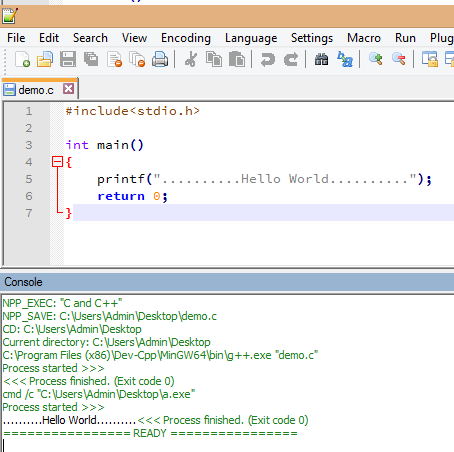Dev C++ Output Window
Nov 15, 2011 Windows.h C Tutorial 5: Creating a Text Field and Storing its Content - Duration: 15:46. Ryan Shanks 57,407 views. You can get visibility into the health and performance of your Cisco ASA environment in a single dashboard. View VPN tunnel status and get help monitoring firewall. Enjoy coding with Dev-C in Windows 8 and Next Version of Windows Operating System Hello Folks, Today i am going to share the steps to install Dev-C in your windows OS and also will share the detail how to fix the Windows not responding problems during compilation time of and coding. Nov 08, 2014 Actually this problem is solved in the newer version of the Dev C.So either download that. Or Just put a getchar at the end of your code just before the return statement and so after the code completes its execution, the terminal window would disappear only when you press some key.
-->The command window tries to load the code for about 5 seconds and then it gives up, when usually it takes about 1 second to see my output. After it tries to load, the command window stays scrolled down all the way at the bottom. Usually the code appears at the very beginning of the command window, so when I tried to scroll up, the side bar.
The Output window displays status messages for various features in the integrated development environment (IDE). To open the Output window, on the menu bar, choose View > Output, or press Ctrl+Alt+O.
Toolbar
The following controls are shown in the toolbar of the Output window.
Show output from
Displays one or more output panes to view. Several panes of information might be available, depending on which tools in the IDE have used the Output window to deliver messages to the user.
Find Message in Code
Moves the insertion point in the code editor to the line that contains the selected build error.
Go to Previous Message
Changes the focus in the Output window to the previous build error and moves the insertion point in the code editor to the line that contains that build error.
Go to Next Message
Changes the focus in the Output window to the next build error and moves the insertion point in the code editor to the line that contains that build error.

Clear all
Clears all text from the Output pane.
Toggle Word Wrap

Turns the Word Wrap feature on and off in the Output pane. When Word Wrap is on, text in longer entries that extends beyond the viewing area is displayed on the following line.
Output pane
The Output pane selected in the Show output from list displays output from the source indicated.
Route messages to the Output window
To display the Output window whenever you build a project, in the Options dialog box, on the Projects and Solutions > General page, select Show Output window when build starts. Then, with a code file open for editing, choose Go to Next Message and Go To Previous Message on the Output window toolbar to select entries in the Output pane. As you do this, the insertion point in the code editor jumps to the line of code where the selected problem occurs.
Certain IDE features and commands invoked in the Command window deliver their output to the Output window. Output from external tools such as .bat and .com files, which is typically displayed in the command window, is routed to an Output pane when you select the Use Output Window option in Manage external tools. Many other kinds of messages can be displayed in Output panes as well. For example, when Transact-SQL syntax in a stored procedure is checked against a target database, the results are displayed in the Output window.
You can also program your own applications to write diagnostic messages at run time to an Output pane. To do this, use members of the Debug class or Trace class in the System.Diagnostics namespace of the .NET API. Members of the Debug class display output when you build Debug configurations of your solution or project; members of the Trace class display output when you build either Debug or Release configurations. For more information, see Diagnostic messages in the Output window.
In C++, you can create custom build steps and build events whose warnings and errors are displayed and counted in the Output pane. By pressing F1 on a line of output, you can display an appropriate help topic. For more information, see Format the output of a custom build step.
Scroll behavior
Windows Dev Center
If you use autoscrolling in the Output window and then navigate by using the mouse or arrow keys, autoscrolling stops. To resume autoscrolling, press Ctrl+End.